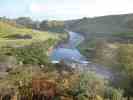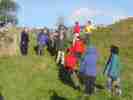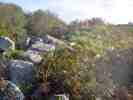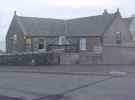|
 Much of his inspiration
for his books came from here and much of the landscape is to be found in
his novels.
The walk was followed in the evening by a lecture on Neil Gunn's Novels
by his nephew Diarmid Gunn.
Two books were also launched. they are reprints of two of the
novels - "Second Sight" and "Wild Geese Overhead".
The events were sponsored by Dunbeath Preservation Society and Whittles
Publishing based in Latheronwheel. They were promoted as part of
Aberdeen University's winter season of lectures in the Highlands. Much of his inspiration
for his books came from here and much of the landscape is to be found in
his novels.
The walk was followed in the evening by a lecture on Neil Gunn's Novels
by his nephew Diarmid Gunn.
Two books were also launched. they are reprints of two of the
novels - "Second Sight" and "Wild Geese Overhead".
The events were sponsored by Dunbeath Preservation Society and Whittles
Publishing based in Latheronwheel. They were promoted as part of
Aberdeen University's winter season of lectures in the Highlands. The walk started at
Dunbeath Preservation Society's museum housed in the old school that Neil
Gunn used to attend. The museum holds a number of collections
including all of the items collected by the Neil Gunn society that ceased
just a few years ago.
 It was a bright and hazy
day rather unexpected considering the bad weather that has been around on
other days and in many other parts of the country with high winds and
rain. In Dunbeath Strath on Saturday 26 October there was none of
that and the walk proceeded in the hazy sunshine with no rain or
even a breathe of wind. It was a bright and hazy
day rather unexpected considering the bad weather that has been around on
other days and in many other parts of the country with high winds and
rain. In Dunbeath Strath on Saturday 26 October there was none of
that and the walk proceeded in the hazy sunshine with no rain or
even a breathe of wind.
For Neil Gunn enthusiasts
it was a chance to have many places pointed out that appear in the novels
one way or another. Nan and George Bethune led the way with Diarmid
Gunn the authors nephew and other experts fielding questions on the novels
and the area.
 The Dunbeath Strath has
been inhabited for thousands of years and is full of archaeological
remains. It bears the marks of glaciation has pictish brochs, stones
and ancient walls. The area is currently being studied to see if the
settlement near the start of the walk was indeed a monastery hundreds of
years ago. The Dunbeath Strath has
been inhabited for thousands of years and is full of archaeological
remains. It bears the marks of glaciation has pictish brochs, stones
and ancient walls. The area is currently being studied to see if the
settlement near the start of the walk was indeed a monastery hundreds of
years ago.
The group visited "Chapel Hill" with its remains on top of an area that
has had much earlier settlement with the old walls perhaps being thousands
of years old. The truth of this may soon be discovered as Historic
Scotland are now to investigate the area.
Neil Gunn walked the a
area often from childhood and returned often in his adult life even when
working in other places. On this day the group concentrated on the
lower part of the strath but it is possible to see much more and discover
many other places that appear in some form in the novels.
 From the school (now the Dunbeath Museum)
that Neil Gunn attended walkers head down the road to a view point
overlooking the village on one side and the harbour on the other. From the school (now the Dunbeath Museum)
that Neil Gunn attended walkers head down the road to a view point
overlooking the village on one side and the harbour on the other.
Then down the road and over the old bridge now overlooked by the giant
flyover bridge carrying modern traffic. Turning left on the other
side of the bridge brings you immediately to the Meal mill. The meal
mill has not operated for many years. the last miller was Adam
Cunningham who served in the First World War with the Seaforth
Highlanders. He lost his right arm on the battlefield. He
managed to operate as a miller despite the difficulties and apparently had
great strength in his remaining arm.. The mill had a lade taking
water from the river. the lade took water from a dam with a sluice.
It was washed away many years ago. The remains of the lade are still
visible along the path where the stonework is easily seen. On the
left is an island that was planted up in former times to be feature.
the trees are all of the same age. Prior to this the island was used
to grow oats at a time when every piece of ground was planted.
 On the right of the path is an area that is
said to have been a monastic settlement and on the ground there is a large
knoll with steep sides referred to as Chapelhill in Gunn's writings. On the right of the path is an area that is
said to have been a monastic settlement and on the ground there is a large
knoll with steep sides referred to as Chapelhill in Gunn's writings.
Neil Gunn's ancestors came from the farm at
Ballachly nearby. He could trace his great grandmother and other
relatives in the area. The Dunbeath broch is clearly visible from
the top of the knoll and the group went to both the knoll and the broch.
There is a great deal to see further up the
strath if you have time to walk along the river up to Prisoners Leap. |




